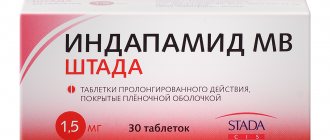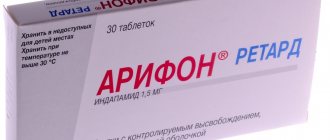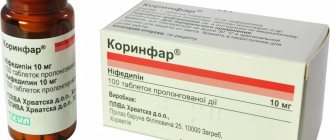Convulex
Contraindicated combinations
Mefloquine: risk of epileptic seizures due to increased metabolism of valproic acid and a decrease in its plasma concentration and, on the other hand, the convulsant effect of mefloquine.
St. John's wort: risk of reducing the concentration of valproic acid in the blood plasma.
Not recommended combinations
Lamotrigine: increased risk of severe skin reactions (toxic epidermal necrolysis). Valproic acid inhibits microsomal liver enzymes that ensure the metabolism of lamotrigine, which slows down its T1/2 to 70 hours in adults and up to 45-55 hours in children and increases plasma concentrations. If the combination is necessary, careful clinical and laboratory monitoring is required.
Combinations requiring special precautions
Carbamazepine: Valproic acid increases the plasma concentration of the active metabolite of carbamazepine to the point of signs of overdose. In addition, carbamazepine enhances the hepatic metabolism of valproic acid and reduces its concentration. These circumstances require the attention of a doctor and determination of drug concentrations in plasma and a possible revision of their doses.
Phenobarbital, primidone: Valproic acid increases plasma concentrations of phenobarbital or primidone to the point of signs of overdose, more often in children. In turn, phenobarbital or primidone enhance the hepatic metabolism of valproic acid and reduce its concentration. Clinical observation is recommended during the first 2 weeks of combination treatment with an immediate reduction in the dose of phenobarbital or primidone if signs of sedation appear, and determination of the level of anticonvulsants in the blood.
Phenytoin: changes in the concentration of phenytoin in plasma are possible; phenytoin increases the hepatic metabolism of valproic acid and reduces its concentration. Clinical observation is recommended, determining the level of anticonvulsants in the blood, changing dosages if necessary.
Clonazepam: The addition of valproic acid to clonazepam in isolated cases may lead to an increase in the severity of absence status.
Ethosuximide: Valproic acid can either increase or decrease the serum concentrations of ethosuximide due to changes in its metabolism. Clinical observation is recommended, determining the level of anticonvulsants in the blood, changing dosages if necessary.
Topiramate: Increases the risk of hyperammonemia and encephalopathy.
Felbamate: increased plasma concentrations of valproic acid by 35-50%, with risk of overdose. Clinical observation, determination of the level of valproic acid in the blood, and changes in the dosage of valproic acid when combined with felbamate and after its discontinuation are recommended.
Neuroleptics, MAO inhibitors, antidepressants, benzodiazepines: neuroleptics, tricyclic antidepressants, MAO inhibitors, which lower the seizure threshold, reduce the effectiveness of the drug. In turn, valproic acid potentiates the effect of these psychotropic drugs, as well as benzodiazepines.
Cimetidine, erythromycin: suppress the hepatic metabolism of valproic acid and increase its plasma concentration.
Zidovudine: Valproic acid increases the plasma concentration of zidovudine, leading to increased toxicity.
Carbapenems, monobactams: meropenem, panipenem, as well as aztreonam and imipenem reduce the concentration of valproic acid in plasma, which may lead to a decrease in the anticonvulsant effect.
Combinations to consider
Acetylsalicylic acid: increased effects of valproic acid due to its displacement from plasma proteins. Valproic acid enhances the effect of acetylsalicylic acid.
Indirect anticoagulants: valproic acid enhances the effect of indirect anticoagulants; careful monitoring of the prothrombin index is necessary when administered together with vitamin K-dependent anticoagulants.
Nimodipine: increased hypotensive effect of nimodipine due to an increase in its concentration in plasma due to the suppression of its metabolism by valproic acid.
Myelotoxic drugs: increased risk of suppression of bone marrow hematopoiesis.
Ethanol and hepatotoxic drugs: increase the likelihood of developing liver damage.
Other combinations
Oral contraceptives: valproic acid does not induce liver microsomal enzymes and does not reduce the effectiveness of hormonal oral contraceptives.
Release form
There are a lot of pharmaceutical products called “Konvulex”, each has its own characteristics. The attending physician should prescribe medications. Even attempts to independently replace Konvulex capsules with tablets, and syrup with drops, can lead to unexpected negative consequences.
The product release form can be presented:
- Tablets – “Konvulex Retard”, 300 and 500 mg of the active ingredient. White, biconvex elements of prolonged action with a vanilla scent, oblong shape, with a score and engraving. Packaged in plastic bottles, which are placed in cardboard packages;
- capsules - 150, 300 and 500 mg of valproate. Elements of a pink hue, which are a liquid in a soft enteric coating. An indicator of the content of the active ingredient is applied to their surface with special ink. The contents are a clear or almost clear liquid;
- syrup - 50 mg of active substance per 1 ml of product. A product developed specifically for the treatment of children. Has a peach or raspberry aroma;
- drops - con with the appropriate content of valproate in 1 ml of liquid. This is a colorless or slightly yellowish composition with the aroma and flavor of orange;
- solution – “Konvulex” 500 mg, which corresponds to 1 ampoule. Per 1 ml of product for intravenous jet or drip administration there is 100 mg of valproate. The liquid is transparent, without color.
All of the above tools are interchangeable, but the use of each has its own characteristics. The products are accompanied by detailed instructions. In some cases, therapy requires compliance with additional rules, which are reported by the doctor.
Overdose
If the level of medicinal dosages is observed, the risk of developing an emergency condition is minimal. In other cases, the likelihood of a negative response from the body increases sharply.
Depending on the degree to which the permissible volume of the composition is exceeded, an overdose is manifested by the following symptoms:
- mild cases – nausea, daytime drowsiness, dizziness, apathy;
- severe intoxication - vomiting, decreased severity of reflexes, decreased muscle tone, acidosis, respiratory failure, constriction of the pupils;
- extreme severity - a critical increase in intracranial pressure against the background of cerebral edema.
First aid consists of gastric lavage and taking enterosorbent. This should be done within the first 10-12 hours after taking an overdose of the medicine. Next, symptomatic therapy is carried out aimed at maintaining body functions. To accelerate the elimination of the active substance and its metabolites, hemodialysis can be performed and the victim can be given diuretics.
pharmachologic effect
The therapeutic properties of the drug "Konvulex" are due to the ability of valproic acid to work in several directions at once. The component increases the tissue content of GABA, the main inhibitory neurotransmitter of the central nervous system. Thus, it stops convulsive activity in parts of the brain, suppressing and preventing seizures. It also relaxes muscle fibers throughout the body, which also helps eliminate anxiety symptoms. Additionally, a sedative effect occurs - inhibition of impulse transmission in the central nervous system causes a maximum reduction in seizure activity.
The listed results are achieved through direct and indirect mechanisms of action of the drug. In the first case, it increases the volume of valproate in the nervous system. In the second, active metabolites of the active substance accumulate in tissues, leading to modification of neurotransmitters.
special instructions
Treatment of epilepsy, even with favorable development of the situation, continues for several years. It is recommended to take valproic acid until the patient has had a period of 2-3 years without attacks. After this, the medicine begins to be slowly withdrawn, extending this process for 1-2 years. A gradual cessation of therapy is accompanied by regular EEG. If pathological changes appear on the study results, the minimum therapeutic volume is returned.
Specifics of treatment based on the drug "Convulex":
- elderly people do not require special dosages, but in their case it is recommended to adhere to the minimum effective volume;
- in case of kidney disease, the volume of medication should be reduced;
- During the entire course, a complete ban on alcoholic beverages is introduced;
- every three months the patient must donate blood for general and biochemical analysis and undergo a coagulogram;
- if some side effects occur, the course is not stopped, but symptomatic therapy is carried out - at the discretion of the doctor.
The use of medication can reduce reaction speed and dull concentration. During treatment, it is better to refrain from driving vehicles or performing hazardous work tasks.
Pharmacodynamics and pharmacokinetics
The use of the product "Konvulex" provides relief from ongoing epileptic seizures,
reducing the frequency of their occurrence prevents relapses. The drug has a positive effect on any type of pathological convulsive activity, the source of which is the structure of the brain. Taking the medication increases the duration of slow-wave sleep, reducing its intermediate phase. A course of treatment improves the general psycho-emotional state of the patient, improves his mood, and prevents the development of arrhythmia.
The rate of absorption, bioavailability and response time of the body to the drug depend on the type of dosage form. Regardless of the route of entry of the drug into the body, its main component and active metabolites cross the placental barrier and enter breast milk. Valproate is processed by the liver. The substance in unchanged form and its breakdown products are excreted mainly by the kidneys, a small amount – by the intestines. The standard half-life of the composition is 8-20 hours. With a decrease in liver performance, in children under 1.5 years of age and elderly people, the indicator can increase significantly.
During pregnancy and lactation
Studies have established the possibility of a teratogenic effect of valproic acid on the fetus. For this reason, Konvulex is prohibited from taking during pregnancy, and during the course women should pay increased attention to contraception. If conception does occur during therapy, discontinuation of the drug should be carried out according to all the rules, and not abruptly, adhering to the minimum dosages. If you suddenly stop taking the medication, seizures may worsen, which will have an equally negative impact on the fetus.
Doctors recommend that people taking the medicine stop breastfeeding. In cases where lactation continues, increased caution should be exercised and the condition of the newborn should be monitored.
Indications for use
The main purpose of the drug "Convulex" is to combat epileptic seizures of any type. These can be various types of generalized or partial disorders, regardless of severity. Despite the versatility of the remedies, it must be borne in mind that the medicine in the form of a solution is only suitable for short-term therapy. It is used in cases where the patient, due to his condition, is unable to take the medication orally.
Also, “Convulex Retard” and standard forms of the drug help with the following conditions:
- specific West and Lennox-Gastaut syndromes;
- involuntary muscle contractions that occur against the background of organic brain damage;
- behavioral changes caused by epilepsy;
- convulsions and tics in childhood, occurring against the background of a significant increase in body temperature;
- bipolar manic-depressive disorders that do not respond to lithium products and other specialized medications;
- any bipolar disorder (treatment and prevention).
This is the official list of what the medicine is prescribed for. In practice, the product can be included in complex therapy for a number of neurological or mental conditions. It is often used in cases where treatment with other compounds of similar action does not give the desired effect.
Contraindications
Most of the prohibitions and restrictions on the use of Konvulex are universal. Different forms of medication have only a number of age-related characteristics. Capsules should not be taken by persons under 3 years of age, and tablets should not be taken by patients under 6 years of age. Drops should not be given to babies if their weight has not reached 7.5 kg.
Therapy is prohibited in the following conditions:
- decreased liver function, acute or chronic hepatitis;
- problems with the pancreas;
- porphyria;
- diathesis of hemorrhagic type;
- a drop in the number of platelets in the blood below the physiological norm;
- intolerance to the drug or its components;
- the use of syrup, capsules and tablets is prohibited in the first trimester of pregnancy and during breastfeeding;
- failures of the urea metabolism process (all forms except solution).
There is also a list of relative contraindications to the use of the Konvulex product. If at least one of them is present, therapy is carried out with increased caution under the supervision of a doctor, or an equivalent replacement is selected for the patient. This group includes pregnancy, reduced kidney function, and blood disorders due to hematopoiesis failure. Danger may include previous diseases of the pancreas or liver, organic brain damage, mental retardation in a child, and protein deficiency in the blood.
Analogs
Pharmacies offer many synonyms and analogues of the product "Convulex". The former also contain valproic acid, which gives them the necessary characteristics. The group includes: “Apilepsin”, “Valparin”, “Depakine”, “Encorat”.
You can learn more about Valparin here.
Drug analogues contain other active ingredients or their composition is supplemented with excipients. These include drugs such as Keppra, Levetiracetam, Comviron and many others.
You will learn more about the drug "Depakine" here.




